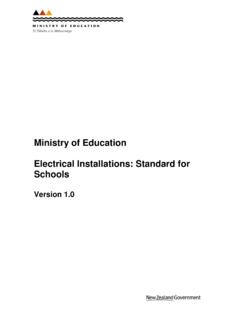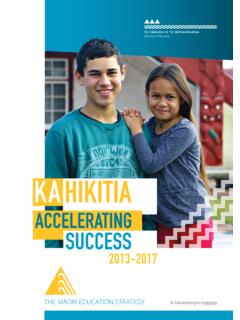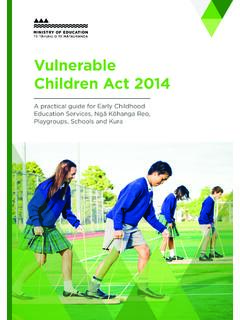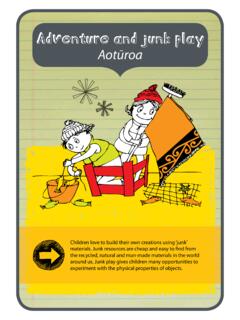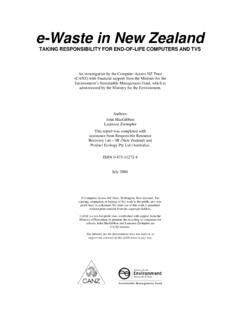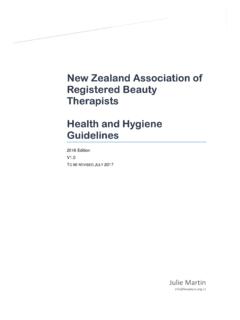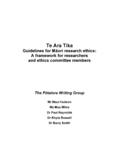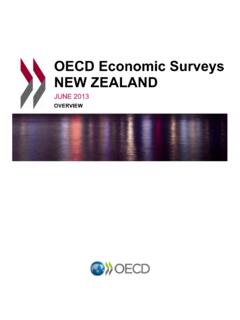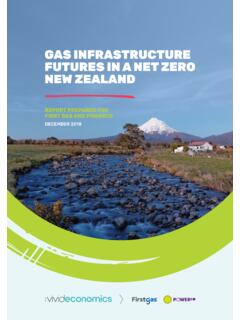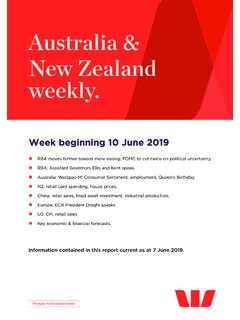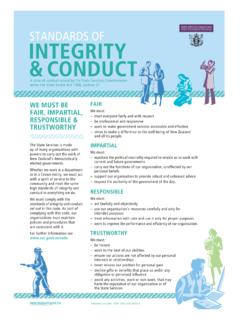Transcription of Vulnerable Children Act 2014 - Education in New Zealand
1 1 Vulnerable Children Act 2014 Vulnerable Children Act 2014A practical guide for Early Childhood Education Services, Ng K hanga Reo, Playgroups, Schools and Kura23 Vulnerable Children Act 2014 About this guideThis guide provides an overview of the Vulnerable Children Act 2014 (VCA) and the responsibilities of early childhood Education services, ng k hanga reo, playgroups, boards of trustees, schools and kura. The guide is for managers, leaders and Children s workers. We recommend all Education managers and leaders read this is intended as a supplementary resource to support the Education sector s Children s workforce to develop a clear understanding of what the VCA means for them. However, the primary source of information must be the VCA itself, the supporting regulations, and the guidelines produced by the Children s Action Plan guide is for early childhood Education services, ng k hanga reo and playgroups (Services), schools and kura (schools).
2 This guide brings together Education sector specific information and tools produced by the Ministry of Education and the New Zealand School Trustees Association (NZSTA) to support Services and schools and to understand and effectively implement the requirements of the VCA and its regulations. We will continue to support Services and schools, as required, to help create a New Zealand -wide culture of child guide provides high-level information about each key requirement of the VCA, with supporting Education sector specific resources and links to further information in the Children s Action Plan guidelines. Refer to page 47 for all does not constitute legal advice and you should obtain your own legal advice on any matter relating to the recommend you also browse the detailed VCA information available online: 1: An overview of the Children s Action Plan and Vulnerable Children Act 2014 The Green Paper and White Paper for Vulnerable Children The Children s Action Plan Children s Teams Vulnerable Children Act 2014 Child protection policies Safety checking Core competencies Joint responsibility of agency chief executives When the requirements come into force Educative approach 12 Part 2.
3 Children s Teams Children s Teams Lead professionals Children s worker safety checking requirements for Children s Teams 13 Part 3: The Vulnerable Children Act 2014 The Vulnerable Children Act 2014 Scope of the VCA Regulated service Children s workers How do you know if a Children s worker is a core worker or a non-core worker? Summary of the scope of the safety checking requirements 165 Vulnerable Children Act 2014 Part 4: What checks do you need to do on people in your Service or school? Staff you employ or engage Teachers Teacher aides and other support staff delivering Education services Relieving teachers Relievers you ve previously safety checked Relying on a safety check done by someone else on your behalf Relying on checks done previously Short-term emergencies Relieving agencies Summary of safety checking for relievers Students on practicum Work experience Work experience not in a regulated service Work experience in a regulated service Safety checking students coming to your Service or school on work placements Gateway Secondary School Employer Partnerships (SSEP)
4 Summary of safety checking for students on practicum Confirmation of safety checking status of other Children s workers who work with Children in your Service or school People who work with Children in your Service or school or early learning centre that you don t employ Responsibility for safety checking self-employed people who work with Children Safety checking (or Police vetting) volunteers Playcentres School camps Billeting Providing confirmation of the safety checking status of your own staff working in other environments Police vetting under the Education Act 1989 Teaching staff Non-teaching and unregistered employees Contractors builders, plumbers, electricians etc who do not work with Children Over 17 year olds in home-based Services Summary of checking requirements for Services and schools 27 Part 5.
5 Components of a safety check Identity confirmation Information about previous criminal convictions (if any) Police vet Police vetting as part of a safety check under the VCA Police vetting results The Criminal Records (Clean Slate) Act 2004 Overseas criminal convictions Other information Interview Reference checking Risk assessment and making a decision Periodic safety checks Record-keeping and audit requirements ERO reviews Summary of safety checking for new and existing employees The Workforce Restriction and the Core Worker Exemption The Workforce Restriction The Core Worker Exemption How does the Core Worker Exemption affect teachers? Schedule 2 Specified offences under the VCA 38 Part 6: Child protection policies Child protection policies Child protection policies timeframes Developing child protection policies The requirements of child protection policies Guidelines on writing high quality policies Who should it apply to?
6 Examples of Education sector child protection policies Example child protection policy for Services NZSTA s example child protection policy 42 Part 7: Education sector responsibilities under the VCA 44 Part 8: Related resources, information and guidelines 47 Part 9: Glossary 4889 Vulnerable Children Act 2014An overview of the Children s Action Plan and Vulnerable Children Act The Green Paper and White Paper for Vulnerable ChildrenSometimes we fail to keep Children safe and sometimes Children are abused or neglected by the very people we trust to keep them safe. In July 2011 the Government released a Green Paper for Vulnerable Children , asking New Zealanders how we could better protect our Children from abuse and submissions in response to the Green Paper formed the basis of the White Paper for Vulnerable Children .
7 On 11 October 2012 the then Minister for Social Development, Hon Paula Bennett, announced a major cross-government project which drew from those submissions to produce a cross-sector action plan to address child vulnerability the Children s Action Plan. The Children s Action PlanA better future for Vulnerable Children is at the heart of the Children s Action Plan (CAP). It s designed to deliver the vision described in the White Paper for Vulnerable Children every child in Aotearoa New Zealand being able to thrive, belong and achieve. The Children s Action Plan is a framework for New Zealanders to know what action is needed to protect Children and when each milestone is reached. It is a living document that will continue to evolve as New Zealanders work together to achieve the fundamental changes contained in the White Paper.
8 It is administered by the Children s Action Plan Children s Action Plan outlines a number of steps to be taken to safeguard Children . These include the:1. development of Children s Teams2. introduction of the Vulnerable Children Act 2014 3. introduction of child protection policies required under the Act4. introduction of new obligations for vetting and screening processes, and 5. setting of minimum standards and core competencies for those working with protection is everyone s responsibility including the Education sector. Together, the Ministry of Education and our Education sector partners are jointly accountable for the wellbeing of Children including the identification of and response to those at risk of harm. We are working together to prepare for and implement a number of changes.
9 The CAP and the VCA together create significant changes to how we protect and improve the wellbeing of Children in New Zealand . While some of the legislative changes apply only to paid employees in state-funded organisations ( safety checking), the CAP envisages improvements in practice across the whole Children s Teams Children s Teams model a different way for agencies to work together to support Vulnerable Children whose needs do not meet the statutory intervention threshold of Child, Youth and Family (CYF). Ten teams across the country are structured to support practitioners and professionals across different disciplines ( health, Education ) to bring together services available for Vulnerable Children into one personalised plan for each child and their family/wh Vulnerable Children Act 2014On 1 July 2014 the VCA passed into law.
10 It forms a significant part of the measures to protect and improve the wellbeing of Vulnerable Children and to strengthen our child protection system. The VCA introduced the requirement for agencies to develop and implement child protection policies and safety checking. It also introduced a definition for people who work with Children Children s workers and extended the responsibility of child protection beyond CYF and the Police to include all government-funded Children s Child protection policiesThe VCA introduced the requirement for prescribed state services, district health boards, school boards, and certain people with whom those services or boards enter into contracts or funding arrangements to adopt child protection child protection policy describes the processes and procedures that an organisation will follow to ensure Children are safe so that the potential for abuse and neglect is identified and responded development of child protection policies is an important opportunity for Services and schools and their communities to reflect on their cultures and begin the process of changing expectations.
